This article shows how to roll back Microsoft Office to the previous version. Microsoft recommends users keep Microsoft Office to the latest version because new updates increase the security of the Office suite and also fix bugs reported by users. In some cases, installing the latest update in Microsoft Office causes issues with some Office applications.

How to roll back Microsoft Office to the previous version on Windows 11/10
When a Windows Update causes issues, we can roll back our computer to the previous build by uninstalling that particular update. This is also possible with Microsoft Office. However, the method to roll back an Office Update is different from rolling back the Windows Update.
Restoring Microsoft Office to the previous version requires you to follow these steps:
- Installing Office Deployment Tool
- Defining the targeted Office version in the configuration file
- Running the required command
- Manually force Office to download and install the required update
All these steps are explained below in detail. Do note that you can roll back only Microsoft Office Click-to-run applications.
Before proceeding, it is necessary to note down the current version of Microsoft Office. For this, go through the following instructions:
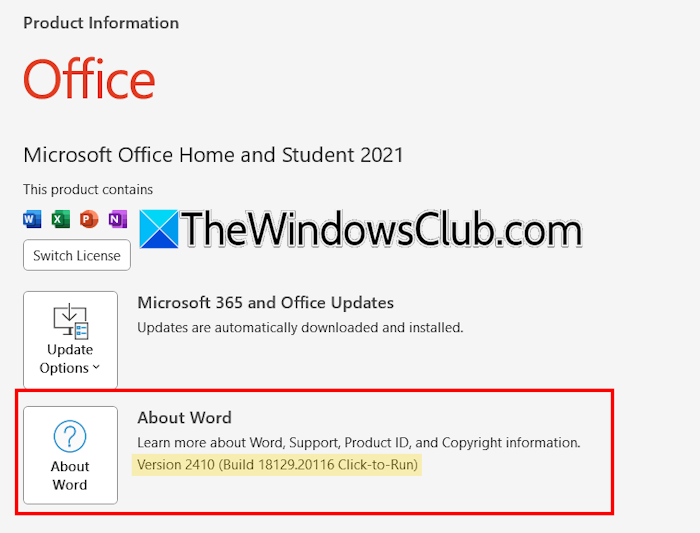
- Open any Microsoft Office application.
- Select the Account option from the left pane.
- You will see the Office version number and build number in the About section.
Note down the current Office version.
1] Install the Office Deployment Tool
Visit Microsoft’s official website and download the Office Deployment Tool. Run the setup file. It will ask you to select a location on your system to save the extracted file. Select any location and click OK. After that, you should see the “Files extracted successfully” message on your screen.
2] Define the targeted Office version in the configuration file
The next step is to define the targeted Office version in a configuration file. First, visit the official Microsoft website to view the Office update history. Search for the Office version or build number currently installed on your system. Once you find it, copy any build number lower than the Office build number currently installed on your system.
Now, open Notepad, copy, and paste the following command in it:
<Configuration> <Updates Enabled="TRUE" TargetVersion="16.0.aaaaa.bbbbb" /> </Configuration>
In the above command, replace aaaaa.bbbbb with the version number you copied. For example, if your targeted version to roll back Office is 18025.20160, the command will be:
<Configuration> <Updates Enabled="TRUE" TargetVersion="16.0.18025.20160" /> </Configuration>
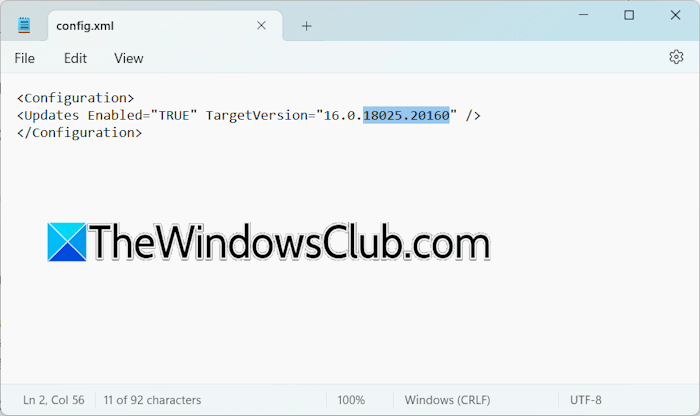
Save the Notepad file at the same location where you extracted the Office Deployment Tool. While saving the file, name it as config.xml.
3] Run the required command
The next step is to run the required command. Before proceeding, close all Microsoft Office applications. Open the Command Prompt as an administrator, copy the following command, paste it into the command prompt window, and press Enter.
setup.exe /configure config.xml
Before running the above command, you should change the directory where you have saved the Notepad configuration file and Office Deployment Tool. Otherwise, you will get the following error:
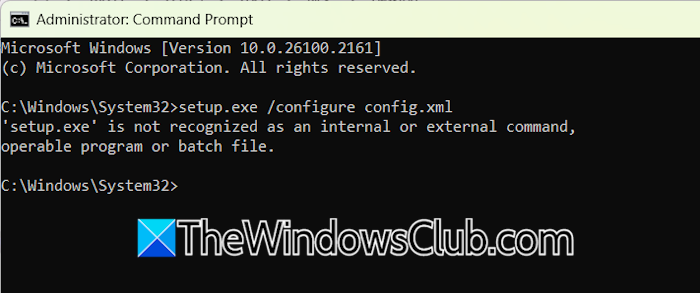
‘setup.exe’ is not recognized as an internal or external command, operable program or batch file.
To change the directory, type the complete path after the command cd. For example:
cd complete path
The above command will not work if you have saved the configuration file and Office Deployment Tool to another drive. In such a case, first type the drive letter and hit Enter. After that, type the required command. For example, in my case, I saved the files to the following path on D drive:
D:\The Windows Club\Images\0
The commands that I used to change the directory are:
D: cd D:\The Windows Club\Images\0
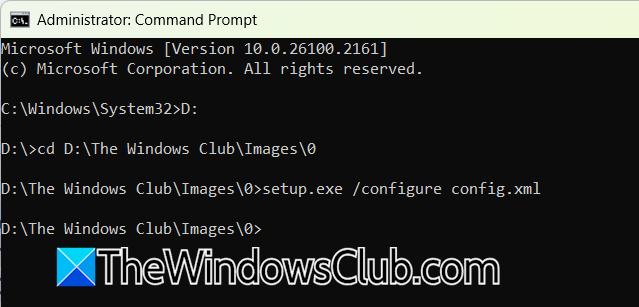
I pressed Enter after typing each of the above-mentioned commands. Now, type the following command and hit Enter.
setup.exe /configure config.xml
When the command executes successfully, a popup window of Microsoft Office will appear on your screen and close immediately. Now, open any Office application and go to Account > Update Options > Update Now. You will receive a message to save your work before continuing. Save your pending work and click Continue. The office will start downloading the required version and install it.
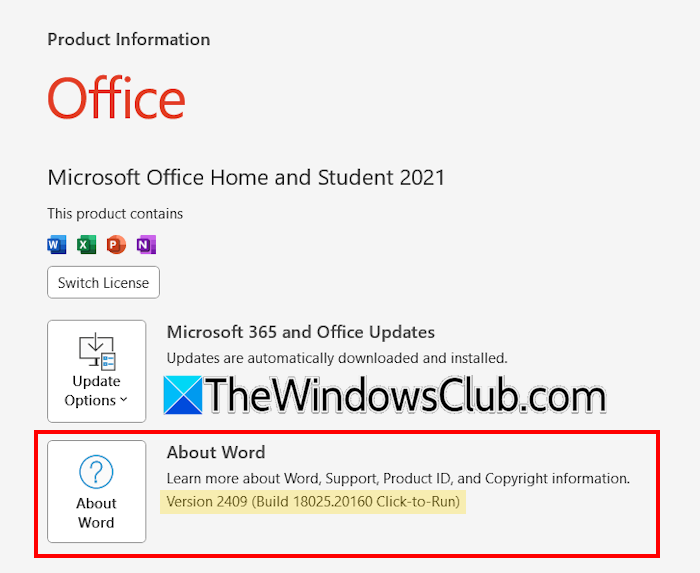
After the update completes, open any Office application, go to Account, and see the version or build number in the About section. You can see in the above screenshot, my Office version has been rolled back to the previous version.
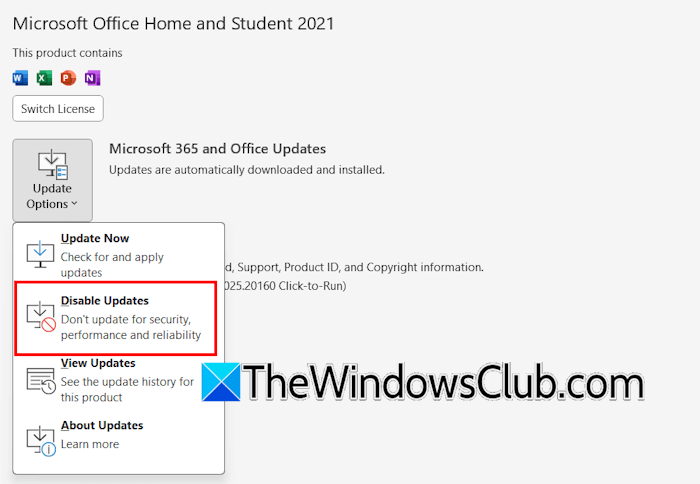
The Office version has been successfully rolled back to the desired version. However, Office may download the latest update and install it if the Automatic Update is configured. If you are facing issues with the latest Office version, you can disable the Automatic Updates in Office to stop it from being updated automatically. In the future, when Microsoft releases a newer update, you can update your Office suite to that version manually.
That’s it. I hope this helps.
Related: How to download earlier versions of Microsoft Office
Does Microsoft Office have a Version history?
Yes, Microsoft Office has a version history. The Version history is available on the official website of Microsoft. You can view the Office version history there and read complete details about each Office update by clicking on the respective link.
Read: How to switch From Click To Run Office To MSI Edition
How do I revert Outlook to an old version?
The new Outlook app is the most recent version of the Outlook app for Windows 11/10. If you want to use the classic or old Outlook app, you can switch from Outlook New to Outlook Classic app by turning off the respective button or modifying Windows Registry.
Can I roll back Outlook to previous version?
To roll back Microsoft Outlook to a previous version, open an elevated CMD, copy-paste the following commands one after the other, and hit Enter:
cd %programfiles%\Common Files\Microsoft Shared\ClickToRun
officec2rclient.exe /update user updatetoversion=OutlookVersionNumber
You have to replace OutlookVersionNumber with the version number of the Outlook you wish to go back to.
Read next: How to uninstall Office Update using command line.
Leave a Reply